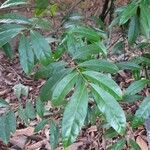Shrub or small tree, up to 9 m by 16 cm. Branchlets reddish-brown. Leaves chartaceous, glabrous, in dry state reddish-brown above, pale brown beneath; elliptic-oblong, (11-)15.5-21(-26) by (3.5-)5¼-7(-10) cm; base acute to attenuate, rarely rounded; apex narrow acute to acuminate, acumen 1.25-2.5 cm; margins sometimes recurved in dry state; nerves 8-10 pairs, elevated beneath, slightly elevated above; veins loosely reticulate, distinct beneath, obscure above; petiole 5 mm. Inflorescences usually terminal and/or in the leaf axils of the terminal node, solitary, sometimes cauliflorous, subsessile or on very short (c. 3 mm) peduncles, with decussate, small bracts at the base. Involucral bracts 4, oblong, ovate or obovate, 6 by 3 mm, usually caducous after anthesis sometimes persistent, usually 8-flowered. Flowers 2.5-4.5 cm long. Floral tube cylindric, gradually enlarged towards the top, glabrous on both surfaces. Calyx lobes oblong or elliptic, 6-7 by 2-3½ mm, puberulous inside and towards the upper part and margins outside, sometimes glabrous outside. Stamens and style usually exserted sometimes up to 5 mm. Pistil sometimes shorter than the tube or about as long as it (BAKHUIZEN VAN DEN BRINK 5063, BAKHUIZEN VAN DEN BRINK/. 688, and San A 3140). Disk cup-shaped. Ovary ellipsoid, glabrous, apex narrowed into the filiform style; stigma capitate, 1½ by 1 mm. Fruits subglobose, 1-1.5 cm in diam., sometimes short-acute at the apex, usually 2-celled, 2-seeded; endocarp inside with distinct meshes.
More
A scrambling shrub. It can grow 2-10 m tall. The stems are black. The leaves are almost opposite and the leaf stalks small. The leaves are broadly oval and 14-18 cm long by 5-10 cm wide. The flowers can be at the ends of branches or in the axils of leaves. There are 8 or more flowers in a group. They are white and a narrow funnel shape. They are 3-4 cm long. The fruit is red and round and about 1 cm across. There are 1 or 2 seeds.

